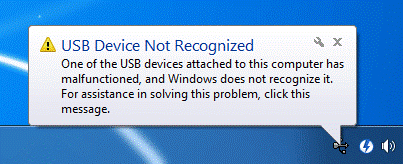USB devices are popular for their ease of use, portability, transfer speeds, and easy access. There are times when the system does not recognize these USB drives and it can be frustrating trying to access content within them.
When you insert such a USB device into your system, you get the following error message:
“USB Device Not Recognized. One of the USBs attached to this computer has malfunctioned, and Windows does not recognize it. For assistance in solving this problem, click this message.”
Once you click on the message box, you will get a recommendation – “Try reconnecting the device. If Windows still does not recognize it, your device may not be working properly.”
In Device Manager, you can see a yellow alert icon, and the device is shown as an Unknown Device under Universal Serial Bus Controllers.
Let us look at a couple of solutions to this problem.
Try a different USB port
- Make sure there is no problem with the USB port.
- Disconnect your USB device and reconnect it via a different USB port. If you are using a desktop, you can try connecting your USB device via a USB port on the back of the case.
- You can also connect the USB device to a different system and see if it works.
Rescan device
- Log onto your system using an Admin account. Press Windows + R button to open the Run dialog.
- Now type msc in the Run box and hit Enter to open Device Manager.
- In Device Manager, click Action -> Scan for hardware changes. The system will try to connect to any new devices connected to your system.
Remove the computer power supply
- The motherboard is where all your hardware is connected, including your USB ports. You have to reboot the motherboard at times when there are issues with the system.
- Once power is removed, the microprocessor on the motherboard will reload drivers for USB ports, the post on which your USB device might be recognized again.
Update USB Device Drivers
Drivers are instructions that can be read by the computer to interact with devices. The drivers contain manuals that tell the computer where it attempts to perform basic input/output actions with the device.
- Click on Start. Type Device Manager in the search box and hit Enter.
- Now expand Universal Serial Bus Controllers. You can find the device tagged as Unknown devices.
- Right-click on the Unknown Device and select Properties. Now click on the Driver tab from the Properties window.
- Click the Update Driver button and choose “Search automatically for update driver software”.
If this doesn’t work, go to the device manufacturer’s website and download the latest drivers. Then you can run the driver installer to install the drivers. Restart the system for changes to take effect.
Fix USB Root Hub
USB device issues can also be caused due to a power management setting.
- Open Device Manager and expand Universal Serial Bus Controllers to locate USB Root Hub.
- Right-click on USB Root Hub and select Properties.
- In the Properties window, select the Power Management tab and uncheck Allow the computer to turn off this device to save power. Then click the OK button.
If there are multiple USB hubs on your system, you have to repeat this method for all of them.
Also Read: Optimize Drive Showing SSD as HDD in Windows 10
Recover Data using Yodot Hard Drive Recovery
If your hard drive is inaccessible to your system, it could very well be due to corruption or damage. You can still recover all the data from the hard drive using Yodot Hard Drive Recovery software.
The software shows you in simple steps on how to recover data from the damaged external hard drive.
- Download and install the latest version of Yodot Hard Drive Recovery software.
- Connect your USB drive to the system.
- On the next screen, you see two options – “Partition Recovery” and “Formatted/Re-formatted Recovery”. Click on Partition Recovery.
- Select the damaged USB hard drive and click Next.
- The software scans the USB drive and shows you a list of recovered files through Preview
The software works on all kinds of hard drives including external drives, USB drives, memory cards, memory sticks, and so on. If there are bad sectors on your USB device that are causing inaccessibility of data, the software creates a disk image of the drive bypassing all the bad sectors and then recovers data from the image.
